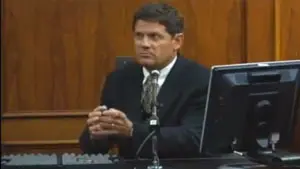

The Expert: Reed Ayers, Ph.D, a biomechanical engineering expert, testifies about the effect of laser etchings on the implant and whether, in his view, a design or manufacturing defect existed.

In a case from the Superior Court of California in Los Angeles, Reed Ayers, a biomechanical engineering expert in the field of material science, testified in support of a successful product liability case against Wright Medical Technology, when concluding a key flaw led to the fracturing of the company’s Profemur R hip implant after its placement in a patient.
The case centered on the laser etchings in the device, how they were created, how that process can influence the strength and durability of the titanium that is marked, and how the process could have been modified to make the implant’s failure far less likely.
Ayers takes complex issues of material engineering and explains them so they are easily understood by the jury, leaving little doubt as to the veracity of his opinion. First, he details the laser etching process to provide the jury with a necessary background for his ultimate conclusions. The titanium implant, he says, has an oxygen layer on it, which can be made thicker or thinner to create visible etchings. Using a laser with adequate power density, controlling precisely how long that light is in contact with the surface, and taking into consideration the wave-length characteristics of the laser itself, one can properly etch the implant without completely vaporizing the surface.
Although Ayers acknowledges he has not seen the settings used to mark this patient’s hip implant, nor knows definitively if such settings actually existed, he details how variations in these settings can influence the implant’s structural integrity. Depending upon these settings, “the laser can significantly degrade the fatigue properties and fracture properties of the device if applied incorrectly,” the expert states. And he confirms that, in this case, “there was significant degradation of the fatigue properties…of this device.”
These fatigue properties are determined by the depth of the markings. In this case, the etchings’ depth of 106 microns would cause a 75% degradation of these fatigue properties, according to Ayers. By contrast, a depth of 25 microns would not have affected the device’s structural integrity. Why then was it necessary to risk the deeper etching? “There is no reason,” Ayers answers, pointing to other etchings on the device, and noting “We can clearly see markings that are only 28 microns deep,” on this same implant. He testifies that, without any laser marks, or with marks only 28 microns deep, the stem of the device would not have fractured.
In this case, the doctor concludes that there was a design defect in the device if any parameters that may have existed in using the laser allowed for an etching 400% deeper than the shallowest mark, which could be seen. “That is a design defect,” he states.
On the other hand, if the design specification cautioned that the deepest etching should be no more than 25 microns, and in the manufacturing process the etchings stretched to a depth 106 microns, then “the laser itself was not well controlled,” allowing a 400% variation in the depth of laser etchings. In such a case, “the manufacturing process is defective.”
Thus, Ayers’ testimony concludes a flaw must have existed somewhere in the process. If there were no parameters to guide the laser etching, or if those parameters did not call for a maximum depth of 25 microns, then there was a design flaw in this device. If there were such stated parameters somewhere, then the fracturing of this device was a result of a manufacturing flaw.
When questioned about alternatives to the manufacturing process Wright used, Ayers explains that all of the etchings could have been made the same depth by using the same power setting on the same laser. Further, and drawing upon his experience in the aerospace industry, Ayers describes a process of using helium or a similar gas as a shield to control the temperature around the point where the laser makes contact with the titanium. This, he says, would help to prevent variations due to reactions with the local atmosphere.
Ayers’ expertise, and his calm, confident testimony were central to the jury’s finding against Wright, and a $4.5 million verdict for the plaintiff.
Gary Gansar, MD, is residency-trained in general surgery. He served as Chief of Surgery and Staff at Elmwood Medical Center and on the Medical Executive Committee at Touro Infirmary and Mercy Hospital in New Orleans, LA. Dr. Gansar was Board Certified in general surgery while in active practice. He joined AMFS in 2015 as a Physician Medical Director.
The medical expert witness partner for attorneys serious about building a winning case
AMFS is your trusted source for highly-qualified medical expert witnesses. After pioneering the field nearly three decades ago, we’re continuing to redefine medical expert witness services by providing value far beyond a referral alone.
Our Physician Medical Directors know what it takes to build a strong case. Our medical expert witnesses leave no doubt. And our case managers streamline billing and logistics every step of the way, letting you focus on what you do best: constructing your winning case. Explore why AMFS clients expect more from their medical expert witnesses—and get it.
